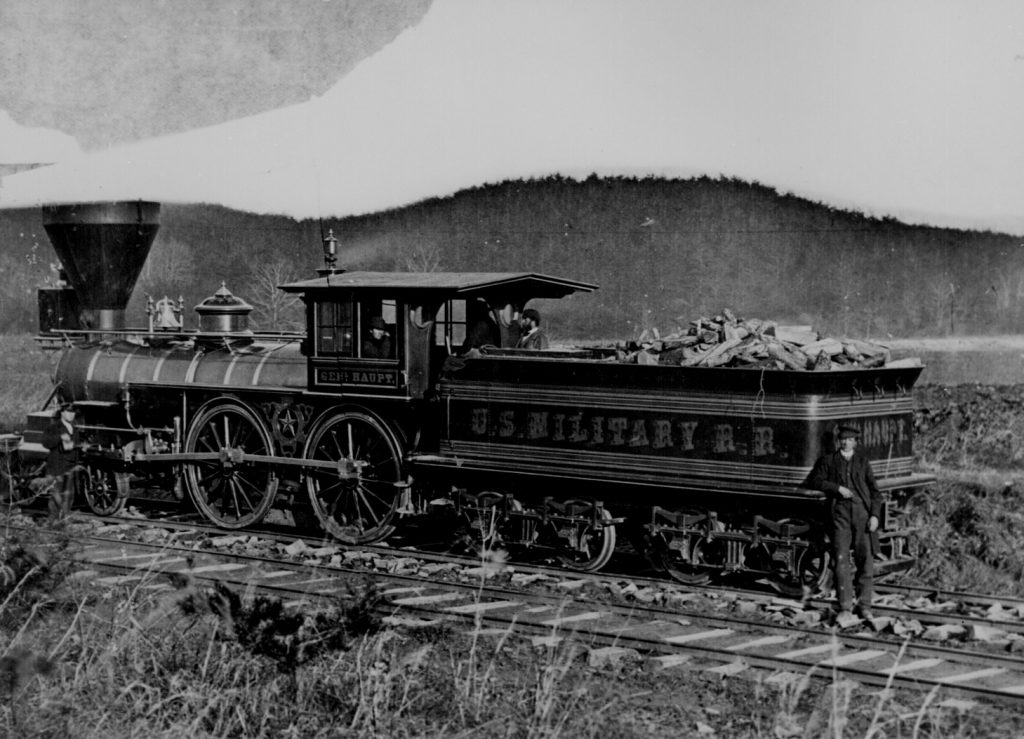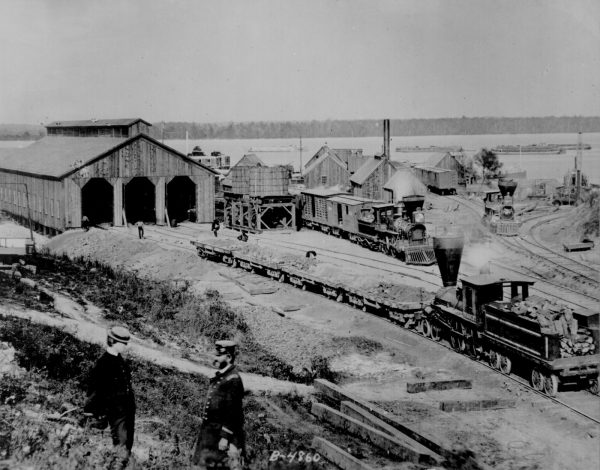Civil War Railroads: An Overview
 As we discuss Civil War railroads this month, let’s start out with some basic concepts. It is important to remember that this was new technology when war broke out. No general, North or South, had ever used railroads in wartime before. Yet now whole armies were moved by rail, and depended on rails lines for supplies, reinforcements, and communication.
As we discuss Civil War railroads this month, let’s start out with some basic concepts. It is important to remember that this was new technology when war broke out. No general, North or South, had ever used railroads in wartime before. Yet now whole armies were moved by rail, and depended on rails lines for supplies, reinforcements, and communication.
The 1830’s saw the formation of many railroad companies in the United States. Because railroads were a new phenomenon, their use was not taught at West Point or other military academies. There was no precedent for wartime railroad management, and commanders on both sides would have to learn on the job.

Officers who had never commanded larger armies before faced the additional struggle of massive logistical support. While railroads made support possible, the challenges of scheduling, estimating supplies over distances, repair and maintenance, and prioritizing traffic were entirely foreign to military officers of the 1860’s. And remember, there was no standard time yet (a product of railroads that was implemented after the war).
An article from the U.S. Army Command and General Staff College notes how revolutionary the use of railroads would be: “Since the dawn of history, military strategy has been dominated by the inexorable calculus of Logistics- distance, time, transport, capacity, and consumption. For thousands of years every army that waged war relied upon the muscles of its men and animals to carry it across the countryside. It is sobering to consider that, up until 1830, every soldier that ever went into battle got there on his own feet or by the efforts of an animal. Every weapon, every round of ammunition, every pound of food eaten by an army, every tent peg, and every bandage reached the battlefield by muscle power.”
Railroads influenced, or impacted, every major campaign of the war. Major combat occurred along rail lines or near transportation centers, such as Manassas, Atlanta, Petersburg, Nashville, Chattanooga, Fredericksburg, Corinth, Richmond, Jackson, Harpers Ferry, and Murfreesboro. Armies were either attacking rail lines and rail depots, or defending them. Examples of campaigns that followed the rail lines include those of middle Tennessee, the Atlanta Campaign, and nearly every offensive launched in Virginia by the Army of the Potomac. Thus railroads, and their management, influenced the strategies of both sides as the conflict unfolded.
Attacks on rail lines could devastate an opponent’s strategy and alter the course of a campaign (as at Holly Springs in 1862). Raids on railroads became standard practice for both sides as the war unfolded.

A deeper analysis of railroads is now in order.
A railroad can carry more payload per given amount of fuel than horses or mules. Therefore they were much more efficient in terms of the return on fuel for their payload. Locomotives of the day could also travel five times faster than horses or mules (the average speed of a wood-burning engine was about 20 miles per hour, but often less).
To keep the convoy itself supplied enroute, a larger percentage of fuel (fodder) needs to be carried on a wagon train than wood for a locomotive. This ‘empty weight’ is known as tare weight: the weight of an empty vehicle or container. In addition, animals pulling need to eat, even when not working. A locomotive does not ‘eat’ (consume fuel) when its not in use. An engine can sit idle for days when not needed, and does not demand a single ounce of fuel. And yes, locomotives at this time used wood, not coal, for fuel. Lastly, supplies and men simply arrived faster and in better condition than when moved (and jostled) by animal power.
Railroads extended the range of operations of armies. There is no way that armies of 100,000 men, or even half that, could operate far from supply bases without steady rail supply. In 1864, General William T. Sherman estimated that his rail lines saved him the use of 36,000 wagons & 220,000 mules.
A soldier consumed three pounds of food a day, a horse 25 pounds. An army of 100,000 men thus needed over 3.5 million pounds of food and supplies per day. That would require 150,000 wagons pulled by 900,000 mules (which causes its own logistical problems). Railroads could meet that demand far more efficiently than animal-drawn wagons.
A final point: simply put, railroads enabled Civil War armies to grow to massive size and thus enabled large battles on a scale never before seen in this country. Thus casualties and devastation was seen on an unheard of level. We know Civil War armies were huge compared to those of the Revolution or other conflicts, railroads are one reason why.
Not only were railroads a game changer and a new challenge to master for commanders, the common soldier would experience that thrill of a lifetime: their very first train ride.
The Union army also had another way to move troops the Confederacy didn’t have. A huge Navy with many more ships. That was a huge advantage for the Union Army, especially in the later years of the war.
Absolutely true! Naval superiority, both on the coast and along the interior rivers, was a huge advantage.
Don’t forget Chickamauga. Without the Railroad, there would be no Longstreet’s Assault!
Absolutely! I didn’t want to get into too many details as I think others are covering the famous large rail movements, but there’s a good example of what railroads enabled the Confederacy to do.